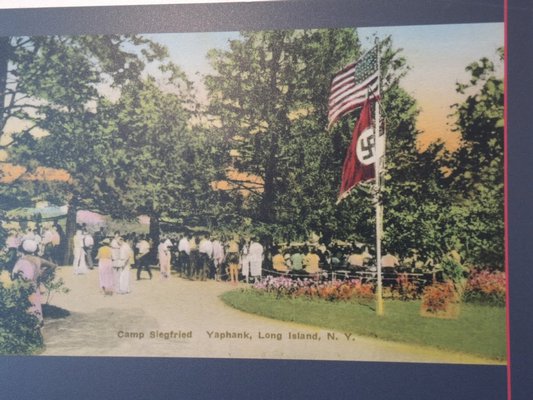
In a divisive presidential election year that has seen even the Ku Klux Klan stumble onto the campaign trail, an exhibit opening at the Riverhead campus of Suffolk County Community College seems particularly timely. “Goose Stepping on Long Island” portrays a time when Nazis flourished near eastern Long Island, at a site called Camp Siegfried. A talk on the camp and its founders will be given this Wednesday, March 9, at 4:30 p.m. at the campus by Steven Klipstein, a professor who curated the exhibit.
It is something like a science fiction writer’s attempt to revise history to imagine streets named for Adolf Hitler, Joseph Goebbels and Hermann Goering anywhere but in Germany on the eve of World War II, but such signs were part of a summer camp in Yaphank. Perhaps more remarkable, the German-American Settlement League, which founded the camp in the 1930s, continues to own the land, which has since sprouted a residential subdivision. Its bylaws include a requirement that homeowners be “of German extraction,” which does not allow for much in the way of racial diversity. It also makes it more difficult to sell a house in the community because of the restricted pool of buyers, which is why last October a couple living in the community filed a federal lawsuit to overturn the requirement.
In the case of Camp Siegfried, the past is more interesting than the present. The first time many Americans learned of the existence of such a camp came in August 1941, as the war waged in Europe, when the New York Times published an article about an attempt to have the signage celebrating the Nazi leaders removed. The offer was made by a man with the appropriate name of Frank Reich to the Brookhaven Town Board, whose members were only too happy to agree.
Camp Siegfried had been founded several years earlier. On Sunday afternoons, thousands of German-Americans headed west to a 42-acre site in Yaphank, which had been purchased in 1936 by the German-American Bund. There they enjoyed the oratory of Fritz Kuhn, whose fiery speeches were highly critical of democracy, communism, blacks, and especially Jews and were exhortations for America to stay out of a possible war. Most of those attending were from neighborhoods in New York City that grew uncomfortable in the summer months, and as the weeks went on listeners learned about the cooler charms of Yaphank.
People who could afford them built cottages and bungalows and others erected surplus Army tents in what was named Camp Siegfried. Streets were created and named for Nazi leaders, and a restaurant was built that featured on the walls photographs of Adolf Hitler and his top officials as well as swastikas, flags and copies of “Mein Kampf.” During one of the biggest pro-Nazi rallies, 2,800 carloads of Nazi supporters and 1,500 travelers took “Camp Siegfried Specials” provided by the Long Island Rail Road, and during the festivities 260 barrels of beer were downed.
The camp did not have a long life. In May 1938, six officers of the German-American Settlement League were arrested for violating civil rights laws. The Suffolk County sheriff seized some of the property in Yaphank to pay the fines levied against the league and the camp’s beer and wine licenses were not renewed. Camp Siegfried and its reasons for existing pretty much ended when the United States entered the war against Germany in December 1941. The present subdivision was created well after the war ended, in 1957, though with the restriction on residents.
“Goose Stepping on Long Island” consists of authentic documents, photographs and other materials that could be found at Camp Siegfried during its height of popularity. According to Professor Klipstein, who is also the assistant director of the Suffolk Center on the Holocaust, Diversity and Human Understanding, “It is important to know that the Nazi Bund existed on Long Island as part of our history. We hope the individuals who see this exhibit will understand the true ramifications of racist language and behavior. Understanding this behavior is as vital now as it has ever been.”
The exhibit at the Riverhead campus of SCCC will remain on view through March 31. There will be a reception before Professor Klipstein’s talk on Wednesday in the Lyceum Gallery. For more information, call (631) 548-2536.